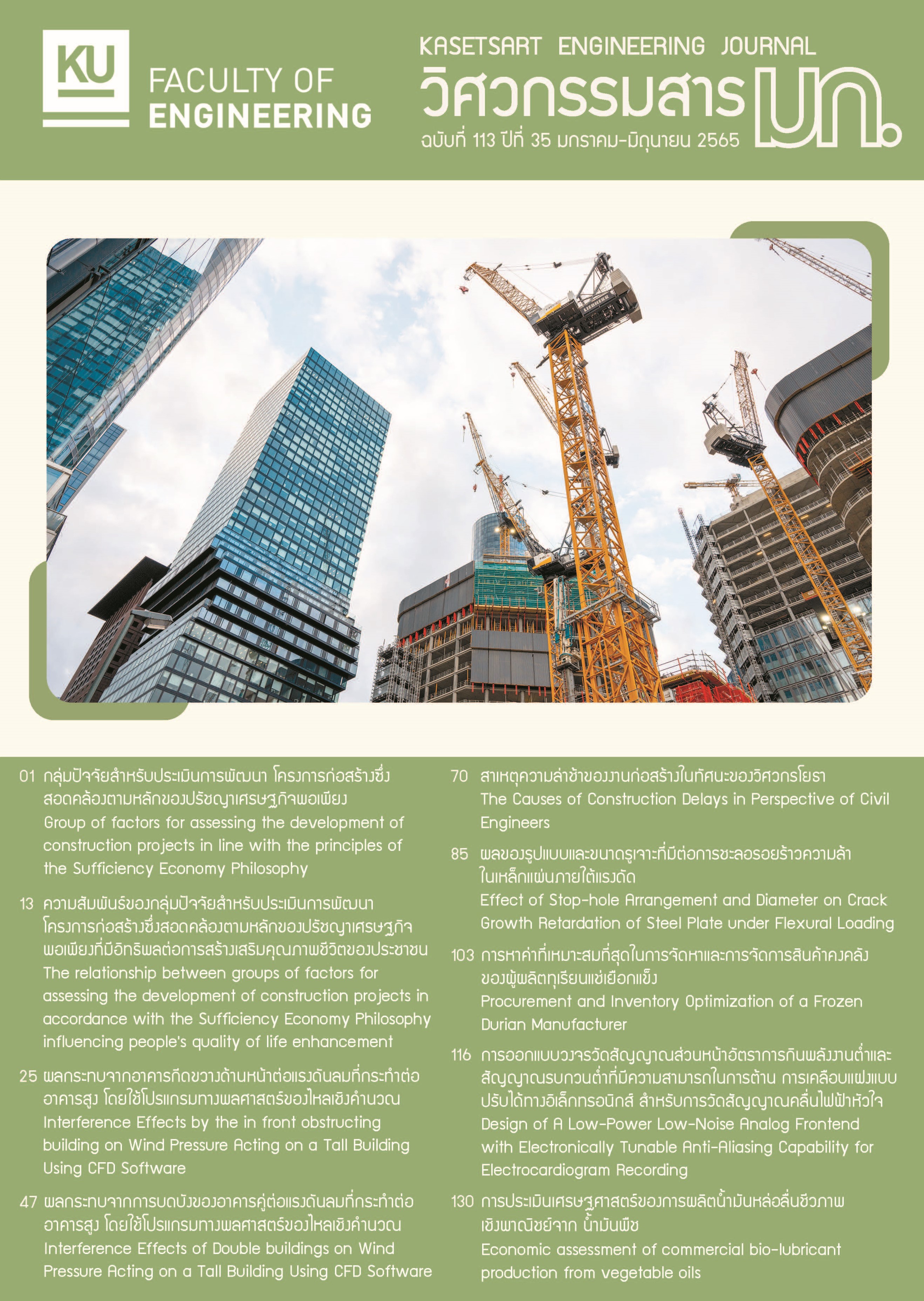ความสัมพันธ์ของกลุ่มปัจจัยสำหรับประเมินการพัฒนาโครงการก่อสร้างซึ่งสอดคล้องตามหลักของปรัชญาเศรษฐกิจพอเพียงที่มีอิทธิพลต่อการสร้างเสริมคุณภาพชีวิตของประชาชน
คำสำคัญ:
การพัฒนาโครงการก่อสร้าง, ปรัชญาของเศรษฐกิจพอเพียง, วิธีการถดถอยเชิงซ้อนบทคัดย่อ
บทความฉบับนี้มีวัตถุประสงค์เพื่อศึกษาความสัมพันธ์ของกลุ่มปัจจัยในการพัฒนาโครงการก่อสร้างที่สอดคล้องตามหลักปรัชญาของเศรษฐกิจพอเพียงที่มีอิทธิพลต่อการสร้างเสริมคุณภาพชีวิตของประชาชนที่สอดคล้องไปตามหลักของเป้าหมายการพัฒนาประเทศที่ยั่งยืน 17 ประการ (SDGs17) ดำเนินการวิจัยเชิงปริมาณ ด้วยการเก็บข้อมูลแบบลิเคิร์ท 5 ระดับ จากวิศวกรที่ปฏิบัติงานเกี่ยวข้องกับโครงการก่อสร้างในประเทศไทย และมีประสบการณ์การทำงานมากกว่า 5 ปี ทั้งในหน่วยงานภาครัฐ ภาคเอกชน และรัฐวิสาหกิจ จำนวน 138 คน วิเคราะห์ข้อมูลทางสถิติด้วยวิธีการถดถอยเชิงซ้อน (Multiple Regression Analysis) โดยใช้กลุ่มปัจจัยที่ประกอบด้วย ตัวแปรอิสระ 7 กลุ่มปัจจัย และตัวแปรตาม 4 กลุ่มปัจจัย ผลการวิจัยพบว่า มีเพียง 5 กลุ่มปัจจัย ที่มีความสัมพันธ์ทางตรงต่อการสร้างเสริมคุณภาพชีวิตของประชาชน ได้แก่ การมีส่วนร่วมของผู้เกี่ยวข้องและผู้ด้อยโอกาส การพิจารณาความจำเป็นและความเหมาะสมทางเศรษฐกิจ การพิจารณาลดผลกระทบจากโครงการ การพิจารณาอย่างรอบด้านเพื่อให้เกิดประโยชน์สูงสุด และการต่อยอดการพัฒนาสู่ชุมชนอย่างยั่งยืน และมีกลุ่มปัจจัยที่เหลืออีก 2 กลุ่มปัจจัยที่ไม่มีความสัมพันธ์ทางตรงต่อการสร้างเสริมคุณภาพชีวิตของประชาชน ได้แก่ การรวบรวมข้อมูลอย่างเป็นระบบและพัฒนาทางเลือกที่เป็นไปได้ทั้งหมด และการทำงานเป็นทีมอย่างมีจริยธรรม ซึ่ง 2 กลุ่มปัจจัยนี้จะนำไปสู่ความสัมพันธ์ที่ต้องอาศัยตัวแปรส่งผ่าน (Mediator variable) ซึ่งเป็นไปตามทฤษฎีความสัมพันธ์ของหลักปรัชญาของเศรษฐกิจพอเพียง โดยความสัมพันธ์ที่สรุปได้จากการศึกษาครั้งนี้สามารถนำไปวิเคราะห์ในงานวิจัยต่อไปได้ เพื่อทำให้การพัฒนาโครงการก่อสร้างสามารถดำเนินการไปได้อย่างมีประสิทธิภาพ และสอดคล้องไปตามหลักของปรัชญาของเศรษฐกิจพอเพียง ซึ่งจะนำไปสู่ความยั่งยืนในระยะยาว ส่งผลถึงประชาชนในประเทศที่จะสามารถใช้ประโยชน์จากโครงการที่พัฒนาขึ้นได้อย่างเต็มประสิทธิภาพ และได้รับประโยชน์สูงสุดจากการพัฒนาโครงการก่อสร้างตามการขยายตัวของเมืองในอนาคต
เอกสารอ้างอิง
Asif M, Muneer T, and Kelly R (2007). Life cycle assessment: A case study of a dwelling home in Scotland. Journal of Building and Environment,42(2007), 1391-1394
Avery, G C & Bergsteiner, H (2016). Practices for Enhancing Resilience and Performance, in Sufficiency Thinking: Thailand’s Gift to an Unsustainable World, Avery & Bergsteiner (eds.) (pp. 235-247). Sydney: Allen & Unwin.
Charoenngam C, Posayanant S, Srivanich S, Orapan Khongmalai O, and Leungbootnak N (2003). KPIs for Infrastructure Development in Tambol Administration Organization. Damrong Rajanubhab; Office of the Permanent Secretary for Interior Ministry of Interior and Asian Institute of Technology. 1st edition printed at Asian Institute of Technology Klongluang PathumThani.
Fei W, Opoku A, Agyekum K, Oppon J, Ahmed V, Chen C and Lok K (2021). The Critical Role of the Construction Industry in Achieving the Sustainable Development Goals (SDGs): Delivering Projects for the Common Good by Sustainability 2021, 13(16), 9112; https://doi.o g/10.3390/su13169112r
Goubran S (2019). On the Role of Construction in Achieving the SDGs. Journal of Sustainability Research. J Sustain Res.2019;1: e190020; https://doi.org/10.20900/jsr20190020
Harvey P (2012). AN INTRODUCTION TO BUDDHIST ETHICS. Publish by Cambridge University Press June 2012; (pp 8-59), (pp187-238); DOI: https://doi.org/10.1017/CBO9780511800801
Harvey P (ed.) (2017). Common Buddhist text: guidance and insight from the Buddha. Mahachulalongkornrajavidyalaya University Press, Bangkok, Thailand.
Horayangkura V, Pimonsathean Y, Weesakul U, Lertpocasombut K, Romratanapun W, Wongsawatgul E, and Klinmalai, S (2007). “In Search of His Majesty the King’s Underlying Concepts in Royally-Initiated Urban, Community and Architecture Development.” Journal of Architectural/Planning Research and Studies, 5(3), 3-27. https://doi.org/10.56261/jars.v5i3.169038
Jibladze G, Romelashvili E, Chkheidze A, Modebadze E, Mukeria M (2021). Assessing Public Participation in Policymaking Process; WeResearch: Tbilisi, Georgia, 2021; (pp. 1–52).
Khaemmani T. (2015). Deciphering the philosophy of sufficiency economy to teach thinking processes: Chulalongkorn University Press.
Marome W (2017). A KNOWLEDGE ASSESSMENT ON SUSTAINABLE CITIES IN THAILAND; Sustainable City. Nakhon Pathom: Industrial Ecology Research and Training Center Faculty of Environment and Mahidol University Resource Center. P 144. ISBN 978-616-443-033-4.
NESDB (2019). NESDB ECONOMIC REPORT(pp. 1-32). https://www.nesdc.go.th/ewt_dl_link.php?nid=8429
Office of the Civil Service Commission (2009). Civil Service Code of Ethics, Royal Gazette, Vol. 126, Special Section 162-4, 73-86.
ORDPB. (2011). Sufficiency Economy Contests 2nd round. Bangkok: Office of the Royal Development Projects Board.
Pongvichai S. (2008). Computer analysis of statistical data. 19th edition Chulalongkorn University Press.
Queensland Government (1994). Public Sector Ethic Act 1994, Division 2 – The ethics values, Queensland Legislation.
Sonet U, Klufallah M, Peters M, and Dixon T (2021). Indicators of the Public Participation Exercise for Designing Public Parks in Malaysia: A Systematic Review. Sustainability 2021, 13(21), 12119; DOI: https://doi.org/10.3390/su132112119
State Services Commission (2005). New Zealand Public service code of conduct, published in pursuant to section 57 of the State Sector Act 1988, Reprint 2005, Crown Copyright, 32.
Terry L, Thomas N, and Skitmore M (2012). Public participation in infrastructure and
construction projects in China: From an EIA-based to a whole-cycle process. Journal of Habitat International 36, 47-56.
Thailand U. N. (2558). Sustainable Development Goals (SDGs). https://www.un.or.th/globalgoals/th/the-goals/.
The World Bank (1994). World Development Report 1994 Infrastructure for Development, Published by Oxford University Press, Inc.
United Nations Office for Project Services, (2014). THE SUSTAINABILITY MARKER TO SUPPORT THE PROJECT SELECTION PROCESS: THE UNOPS CASE. Accepted for publication at PMI Global Congress 2014 – North America Phoenix – Arizona – USA – 2014
Yudelson J (2010). Sustainable Retail Development: New Success Strategies.
ดาวน์โหลด
เผยแพร่แล้ว
ฉบับ
ประเภทบทความ
สัญญาอนุญาต

อนุญาตภายใต้เงื่อนไข Creative Commons Attribution-NonCommercial-NoDerivatives 4.0 International License.


